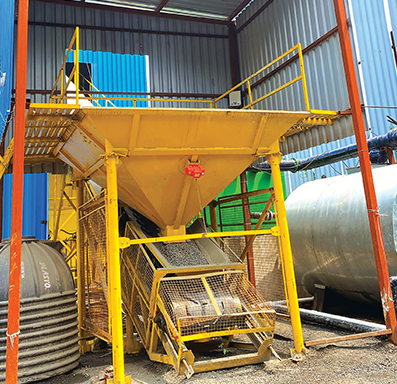Keeping the green agenda on priority at the Bandra WWTF

Even as construction teams aggressively push forward to achieve their milestones to deliver projects, they are mindful of keeping their ‘green’ agenda intact by endeavouring to reduce pollution, use sustainable resources, manage waste efficiently, and more. Perhaps, the onus to keep their environment clean & green is greater on the WET IC team at the Bandra Waste Water Treatment Facility (BWWTF) led by Project Director, Surimal Pande, constructing bang in the middle of one of Mumbai’s poshest suburbs. “Our ‘green’ focus has been to ensure that our batching plants pollute less and transplant some of the trees that we were forced to cut for execution to maintain the green cover in Mumbai,” he declares with determination.

Our ‘green’ focus has been to ensure that our batching plants pollute less and transplant some of the trees that we were forced to cut for execution to maintain the green cover in Mumbai.
Surimal Pande
Project Director


Controlling emissions from batching plants
Batching plants emit dust, particulate matter, wastewater, noise, and solid waste during operations and to mitigate the environmental impact, the BWWTF team has adhered to all the legal regulations, obtaining the necessary environmental permits to comply with the regulatory requirements.
To preserve the air quality, the team deploys dust suppression measures, such as water sprays and dust collectors, to minimize particulate emissions, which are regularly monitored to ensure that the local air quality standards are met.

“It is important to work quietly in such a posh locality,” remarks Sonali B Desai, Assistant Manager – EHS, “for which we created a buffer zone for noise-emanating operations, efficiently maintain our equipment, and strictly follow restrictions for our operations like avoiding working at nights to minimize noise pollution.”

It is important to work quietly in such a posh locality, for which we created a buffer zone for noiseemanating operations, efficiently maintain our equipment, and strictly follow restrictions for our operations like avoiding working at nights to minimize noise pollution.
Sonali B Desai
Assistant Manager – EHS


The excess concrete and other material created during construction are recycled to reduce waste, which along with other hazardous waste, are disposed of in accordance with the regulations. Buffer zones help the team to maintain appropriate distances between the residential areas and the batching plant operations.
What is monitored is recognized, and Surimal is meticulous that everything that the team does towards sustainability is documented. “Before establishing a plant, we conducted assessments to evaluate the potential impact on the local ecosystems and communities and thereafter have obtained all the necessary environmental permits from the local, state, and federal agencies,” he informs, adding that the records of operations, emissions, and compliance measures for regulatory reviews are carefully maintained.

More controls to keep the air clean & workers healthy
GI sheets installed around the batching plant prevent dust particles from escaping into the air while dumpers are covered to contain the dust and particulate matter. “We have silos with dust-tight seals and filters to store bulk materials like cement and aggregates that minimize dust emissions,” mentions Sonali. Screw conveyors in their batching plants reduce dust emissions, improve material handling, and ensure their compliance with environmental standards. The automated water sprinklers help the team to efficiently use water too. In addition, during excavation, demolition, & material handling,
anti-smog machines are pressed into service.

Transplanting 161 trees
“Since we had to cut a fair number of trees to execute our project, we strongly felt that we had to give something back to nature and so successfully transplanted 161 trees without compromising between development and conservation,” shares Surimal, with satisfaction.

Starting with a site assessment to evaluate the original and new locations for suitability of the soil type, sunlight, and drainage, the team followed a very precise methodology for this process. The trees were then prepared by watering them thoroughly to reduce stress and prepare the roots that were pruned to encourage new root growth. The ground was carefully dug up around the root ball to ensure that it remained intact. Transported using a tarp or a specialized equipment, the trees were placed in the new location, in the same depth as before, backfilled with soil and then watered to eliminate air pockets. “Our work is not over with the transplantation, for there is posttreatment care too. We keep monitoring the trees for signs of stress, providing as much as water and mulch to aid recovery,” rounds off Surimal.
Environmental compliance is not just a regulatory requirement but a moral responsibility towards our planet, and the dedication of the Bandra WWTF team to integrate these compliances into every phase of the construction process ensures that the project aligns with sustainable development goals, protecting ecosystems and maintaining the quality of life for the surrounding communities. Having kept their ‘green’ agenda, the challenge before Surimal and his team is to keep up their good practices till they deliver their project.